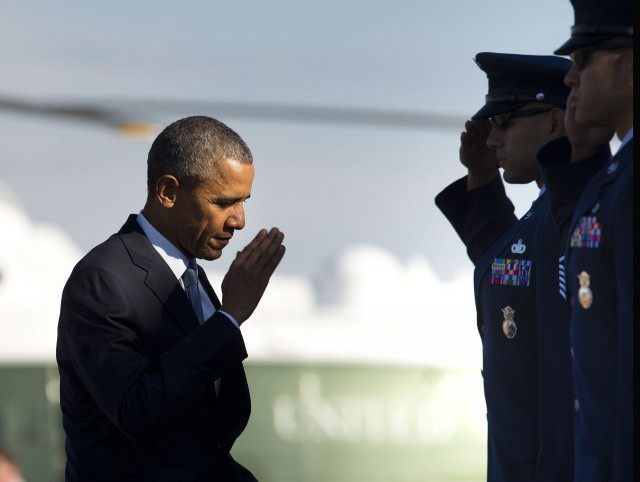WASHINGTON, D.C. — The U.S. military fighting the war in Afghanistan, now in its 15th year, has been drawn into combat against a resilient Taliban a year after President Obama said American troops had ceased their combat mission in the country, reports a watchdog agency appointed by Congress.
Since President Obama declared an end to the combat mission on Dec. 31, 2014, security conditions have deteriorated, the Taliban’s reach in Afghanistan is greater than at any point since 2001, and the performance and capabilities of Afghan National Defense and Security Forces (ANDSF) have been deemed less than desirable, notes the watchdog known as the Special Inspector General for Afghanistan Reconstruction (SIGAR) John Sopko.
Earlier this year, Pentagon press secretary Peter Cook was hesistant to say that the U.S. military had been engaged in combat operations after one soldier was killed and two others wounded while fighting the Taliban, eventually saying their predicament constituted a “combat situation.”
In its latest quarterly report to lawmakers, SIGAR reveals that during the reporting period of Oct. 1 thru Dec. 31, 2015, “Afghanistan proved even more dangerous than it was a year ago.”
“The Taliban now controls more territory than at any time since 2001. Vicious and repeated attacks in [Afghan capital] Kabul this quarter shook confidence in the national-unity government,” reports Sopko. “A year after the Coalition handed responsibility for Afghan security to the Afghan National Defense and Security Forces (ANDSF), American and British forces were compelled on several occasions to support ANDSF troops in combat against the Taliban.”
President Obama declared a “responsible” end to the U.S. combat mission at the end of 2014, marking the beginning the train, assist, and advise (TAA) role for American troops at the beginning of January 2015 as the ANDSF, which includes army, police, and militia units, assumed responsibility for the security of their own country.
U.S. service members have continued to pay the ultimate sacrifice in Afghanistan after the combat mission was declared over.
Since the alleged end of the combat mission on Dec. 31, 2014, there have been at least 21 U.S. military fatalities and 79 service members have been wounded, bringing the totals to 2,227 deaths and 20,109 injuries.
The majority of those casualties have occurred under the watch of President Obama, who escalated the war soon after taking office in January 2009.
“Our combat mission in Afghanistan is ending and the longest war in American history is coming to a responsible conclusion,” said the president in December 2014.
However, SIGAR indicates that the war is far from over. A recent report by The Washington Post quotes unnamed defense officials as suggesting that the war in Afghanistan will last for decades beyond 2017, when President Obama had indicated it would end.
“This quarter, there were several reports of U.S. Special Forces fighting alongside Afghan security forces. While the United States has two non-combat missions—training Afghan forces and supporting counterterrorism operations against the remnants of al-Qaeda—U.S. forces are also being drawn into fighting the Taliban,” Sopko tells Congress.
“The Helmand Province operation in January was not the first time U.S. forces partnered with Afghans in fighting the Taliban. During the Kunduz siege in October, General Campbell reported U.S. forces engaged in heavy fighting for five consecutive days and nights,” he adds.
U.S. Army Staff Sgt. Matthew Q. McClintock was killed and two other soldiers wounded in the Helmand operation.
Security conditions have deteriorated in Afghanistan.
In the months between August and the end of October of last year, “the overall level of security incidents increased and intensified… with 6,601 incidents as compared to 5,516 incidents (19% increase) during the same period in 2014,” reports SIGAR, citing the United Nations.
“The 6,601 security incidents reported were the most since SIGAR began reporting in November 2012, and the average daily number of incidents that occurred equaled the number in the summer of 2014,” it explains.
Despite an investment of nearly $70 billion in U.S. taxpayer funds and years of American military training, the Afghan security forces performance was rated as “uneven, with numerous, high-profile tactical and operational setbacks detracting from its overall success in preventing the Taliban insurgency from achieving its strategic goals,” explains SIGAR.
“ANDSF capability gaps in aviation, intelligence, logistics, maintenance, operational planning, and leadership persist,” it adds. “DOD assessed that the ANDSF continued to improve integration of indirect fire and close-air attack capabilities, but that the ANDSF’s capacity to hold areas after initial clearing operations is uneven: they remain in a primarily defensive posture that limits their agility across the country.”
More than five percent (27 districts across 11 provinces) of the country are under insurgent control or influence, and about 20 percent is at risk, notes SIGAR, without specifically naming an insurgency.
However, U.S. Brig. Gen. Wilson Shoffner, a top spokesman for the U.S.-led NATO coalition in Afghanistan, indicated this month that at least 26 districts are under the control or influence of the Taliban.
There are reportedly a total of 407 districts in 34 provinces in Afghanistan.
The growing Islamic State branch in Afghanistan known as the Khorasan Province (ISIL-K) has established a stronghold in eastern Afghanistan’s Nangarhar province, where the group maintains a presence in at least five districts. Nangarhar borders Pakistan.
According to SIGAR, the majority of security incidents between last August and October occurred in the south, southeast, and east portion of the country, which lies on the Pakistani border.
A recent Pentagon report noted that terrorists fighting the U.S. forces in Afghanistan, namely the Taliban and its affiliate the Haqqani Network, continue to enjoy sanctuary in Pakistan.

COMMENTS
Please let us know if you're having issues with commenting.